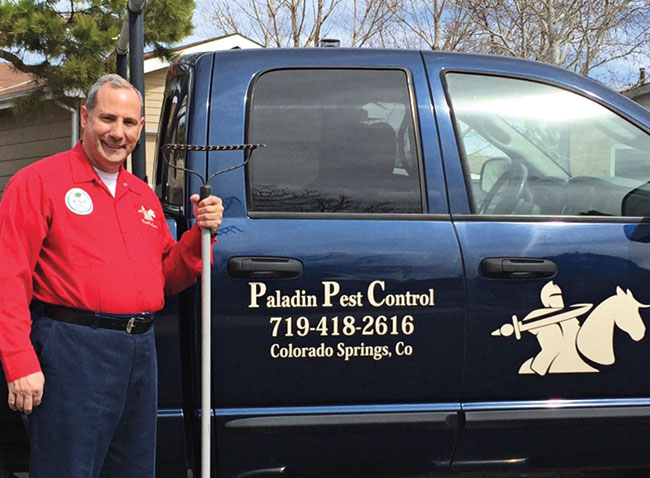May the Schwartz be with them.
It happens to pest management professionals (PMPs) all the time: A customer calls and says he has ants all over the place, but when PMPs arrive at the properties, they often find only a few here and there.
That’s what Edward F. Schwartz, ACE, owner of Paladin Pest Control, Colorado Springs, Colo., expected when he took the call from a new customer complaining about ants “everywhere.” This time, though, the customer wasn’t exaggerating.
“When I got out there, I found out he was really telling the truth. The ants were literally all over the place,” Schwartz says.
After taking one look at the property, Schwartz immediately knew he was dealing with harvester ants (Pogonomyrmex spp.) because, as he notes, it’s basically the only species found in southern Colorado that builds mounds.
The house was on a 5-acre plot of land. Schwartz explains that on a lot of that size, it’s not unusual to see 10 nests. But in this yard, he could see more than 30 nests. Now the pests — he estimates there must have been a couple hundred thousand worker ants — were making their way into the home.
Not only were there a surprisingly large number of nests, there were enormous ant trails, too.
“The trails were about 12-in. wide,” Schwartz says. “That was probably the biggest ant highway I’ve ever seen in my whole career, and I’ve been doing this 20-plus years.”
A large number of ants in a trail indicates a nearby food source, he says, and in this case, the ants were crawling up and down aspen trees.
“It was pretty clear there were a lot of aphids in the aspen trees, because these ants will harvest scaly bugs such as aphids,” Schwartz says. “Their treat is honeydew, which is very sweet. Harvester ants will herd them like we do cattle.”
Now that he knew what he was dealing with, Schwartz asked the customer what he had observed in his home and in the yard.
“It really is important to talk to customers because they live there,” Schwartz says. “We, as professionals, might be on the property maybe an hour.”
| I walked on the property and had them literally going up and down my legs. | ||
|---|---|---|
|
MASTER: Edward F. Schwartz, ACE, Owner, Paladin Pest Control, Colorado Springs, Colo. INVADING SPECIES: Harvester ant (Pogonomyrmex spp.) WAR STORY: More than 30 nests, many with 12-in. wide trails. WINNING WAY: Nest dredging, subsoil injections and trail treatments. |
||
Next, he took a look around the entire property. If he had simply inspected the home and its 10-ft. perimeter, he says, he would have been dealing with callbacks every 10 days.
“What is in the microenvironment — that’s everything outside of the property — is going to eventually find its way inside,” Schwartz says. “So I like to take a look at the property as a whole.”
Then, he took action.
“With any type of ant, the best way to control them or eliminate the problem is to find the nests,” he says. “When it comes to harvester ant nests, that’s easy. They’re mostly above ground.”
Schwartz used a field rake to level the mounds and expose the active foragers and eggs. He then treated every nest.
“We dredged the site and then did a subsoil injection,” he reports.
After Schwartz attacked the nests, he treated the trails. Most ant species will use the terrain to their advantage, he says, and this home had a lot of rock and landscaping materials around it. The ants were trailing the steel edging material to get to the trees.
“I walked on the property and had them literally going up and down my legs,” he says. “It was that severe.”
Within 30 days, however, he eliminated the ants.
You can reach Managing Editor Diane Sofranec at dsofranec@northcoastmedia.net.

Leave A Comment